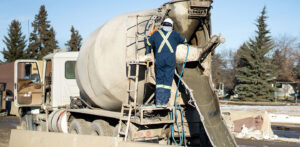
Concrete Truck Capacity: How Much Can Your Drum Really Hold?
At first glance, the question of concrete truck capacity might seem pretty cut and dried. After all, when you research your available options, you’re specifically told what a given drum is rated to hold. And since many redi mix concrete trucks on the road today are rated for anywhere from eight to 11 yards of concrete, shouldn’t it stand to reason that their drums can hold that stated amount of material? Well, yes and no.
As with so many things in construction, working out your concrete truck capacity isn’t quite that simple. (The good news is, it also isn’t all that complicated.) Here, General Chipping’s concrete pros are digging in on all things concrete truck capacity: how much your ready-mix truck can hold, why there’s something of a discrepancy, number-wise, and ways to optimize your concrete truck’s carrying volume.

Concrete Truck Capacity vs. Drum Rating
As we mentioned above, virtually every ready mix concrete truck on the market today includes a rating for its unique mixing drum. This rating points to the drum’s carrying capacity, but it’s important to note that it indicates how much the drum SHOULD hold — not the maximum amount it CAN. For instance, a cement mixer drum rated for 10 yards of concrete is physically able to hold about 14 yards.
Filling your drum up to its maximum limit might feel like the convenient move, potentially cutting down on the number of trips to and from your concrete plant, but it can have costly repercussions. To start, excess material inside an already heavy cement mixer drum adds weight that can throw your drum off balance, impact your pours and result in costly repairs and replacement work. Even more important is your drum’s need for “breathing room” to adequately mix your concrete blend’s ingredients and get it safely to its destination.
Breathing Room’s Important Role in Concrete Truck Capacity
Sometimes in life it’s the things that AREN’T there that make a difference. As it relates to your cement mixing drum, having a little extra space inside can help create a better overall product — all while making for safer conditions. Here’s how:
- Open Space Makes for Easier Blending: If you’ve ever tried pouring one of those powdered drink mixes into a bottle of water without first taking a sip, you know how difficult it is to get everything incorporated smoothly. It’s the same for your redi mix drum. When you leave too little open space inside, you risk allowing pockets of ingredients — in this case sand, cement or aggregate — to clump together, not fully incorporating into the concrete blend. Not only can this result in an inconsistent final product that is difficult to pour and smooth, but it can compromise the strength of the finished concrete.
- Smart Fill Levels Make for Safer Transport: You might be surprised at the sheer number of ready mix trucks that spill wet material along roadways — or worse, on nearby vehicles — while traveling to the job site. The simple truth is, having too much material inside the drum, especially if that drum is rotating to keep ingredients from settling and separating, creates a prime opportunity for spillage. Considering the fact that concrete trucks experience a higher-than-average accident rate, and that the material they transport is fairly permanent once dried and set, such spills can have messy, cost-prohibitive consequences.
- Empty Space Makes for Easier, More Efficient Pours: When you poise your concrete pours for success from the start, it makes every element of the work run a bit more smoothly. You won’t waste valuable time filing accident reports for concrete spills that could have been avoided, or trying to work poorly blended concrete into a pour in a way that isn’t noticeable. In short, you keep your work on schedule and your customers happy, making repeat business much more likely.
Tips to Optimize Your Concrete Truck Capacity
Of course, maintaining an ideal concrete truck capacity doesn’t begin and end with making sure not to overfill your mixing drums. (Nothing is ever that easy, right?) If you want to keep your carrying volume where it should be, and keep your ready mix truck operating as it should, ongoing maintenance will come into play.
The most important aspect of that ongoing maintenance is remembering to book concrete chipping appointments on three-month intervals for your fleet. During these appointments, trained and licensed teams physically enter your truck drums and use handheld jackhammers to remove dried material that has formed along the walls. Because concrete chipping companies are focused on looking after your system as a whole, they’ll usually clean your cement storage silos and central mixers during that same appointment. Remember, such work is dangerous. When handled improperly, it can result in damaged drums, injury or even death. For that reason, you should leave concrete chipping to the professionals.
Your crew might not be carrying out the concrete chipping work itself, but there are things you can do to help keep your drums healthy.
- First, monitor the amount of work you’re requiring of your mixing drums. Since every pour results in some left-behind material, busy seasons mean you might requiring drum chipping on a more frequent basis.
- In addition, you should regularly inspect your drums, silos and mixers for lags, clogs or other telltale signs that something is wrong. If you do notice something is amiss, be sure to report it to your concrete chipping crew. They’ll be able to give things a closer look during your next appointment and can help determine what, if anything, needs to be done.
- Finally, consider incorporating a chemical cement mixer drum cleaner into your maintenance routine. Using such a product between pours can help keep buildup at bay, but it won’t stop it completely. You’ll still need to book regular chipping appointments.
We hope you have a better understanding of your concrete truck’s carrying capacity and the various factors that affect it. If you have additional questions, consider checking out our Resources page — especially the portion that answers the question “What Does General Chipping Consider a ‘Full Load?’”. Ready-mix truck manufacturers often offer helpful information regarding their particular makes and models, too. Of course, you’re always free to contact the concrete chipping pros at General Chipping. Give us a call at 1.866.343.8295 or contact us through our website to get in touch with our crew directly. We’re here, and we’re always glad to help.
